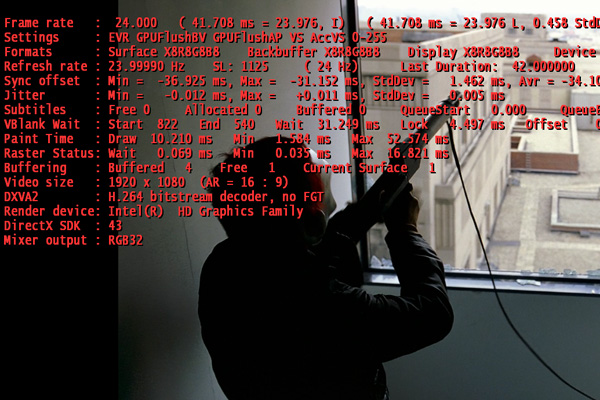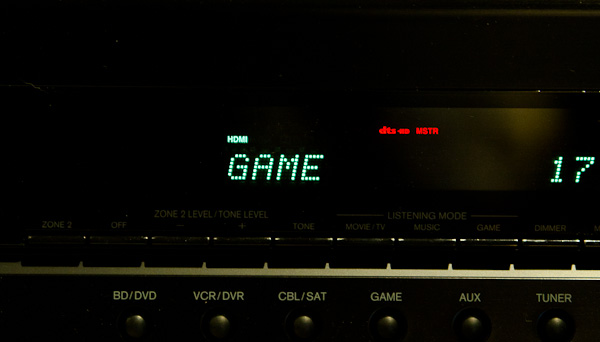The Sandy Bridge Review: Intel Core i7-2600K, i5-2500K and Core i3-2100 Tested
by Anand Lal Shimpi on January 3, 2011 12:01 AM ESTA Near-Perfect HTPC
Since 2006 Intel’s graphics cores have supported sending 8-channel LPCM audio over HDMI. In 2010 Intel enabled bitstreaming of up to eight channels of lossless audio typically found on Blu-ray discs via Dolby TrueHD and DTS-HD MA codecs. Intel’s HD Graphics 3000/2000 don’t add anything new in the way of audio or video codec support.
Dolby Digital, TrueHD (up to 7.1), DTS, DTS-HD MA (up to 7.1) can all be bitstreamed over HDMI. Decoded audio can also be sent over HDMI. From a video standpoint, H.264, VC-1 and MPEG-2 are all hardware accelerated. The new GPU enables HDMI 1.4 and Blu-ray 3D support. Let’s run down the list:
Dolby TrueHD Bitstreaming? Works:
DTS HD-MA bitstreaming? Yep:
Blu-ray 3D? Make that three:
How about 23.976 fps playback? Sorry guys, even raking in $11 billion a quarter doesn’t make you perfect.
Here’s the sitch, most movie content is stored at 23.976 fps but incorrectly referred to as 24p or 24 fps. That sub-30 fps frame rate is what makes movies look like, well, movies and not soap operas (this is also why interpolated 120Hz modes on TVs make movies look cheesey since they smooth out the 24 fps film effect). A smaller portion of content is actually mastered at 24.000 fps and is also referred to as 24p.
In order to smoothly playback either of these formats you need a player and a display device capable of supporting the frame rate. Many high-end TVs and projectors support this just fine, however on the playback side Intel only supports the less popular of the two: 24.000Hz.
This isn’t intentional, but rather a propagation of an oversight that started back with Clarkdale. Despite having great power consumption and feature characteristics, Clarkdale had one glaring issue that home theater enthusiasts discovered: despite having a 23Hz setting in the driver, Intel’s GPU would never output anything other than 24Hz to a display.
The limitation is entirely in hardware, particularly in what’s supported by the 5-series PCH (remember that display output is routed from the processor’s GPU to the video outputs via the PCH). One side effect of trying to maintain Intel’s aggressive tick-tock release cadence is there’s a lot of design reuse. While Sandy Bridge was a significant architectural redesign, the risk was mitigated by reusing much of the 5-series PCH design. As a result, the hardware limitation that prevented a 23.976Hz refresh rate made its way into the 6-series PCH before Intel discovered the root cause.
Intel had enough time to go in and fix the problem in the 6-series chipsets, however doing so would put the chipset schedule at risk given that fixing the problem requires a non-trivial amount of work to correct. Not wanting to introduce more risk into an already risky project (brand new out of order architecture, first on-die GPU, new GPU architecture, first integrated PLL), Intel chose to not address it this round, which is why we still have the problem today.

Note the frame rate
What happens when you try to play 23.976 fps content on a display that refreshes itself 24.000 times per second? You get a repeated frame approximately every 40 seconds to synchronize the source frame rate with the display frame rate. That repeated frame appears to your eyes as judder in motion, particularly evident in scenes involving a panning camera.
How big of an issue this is depends on the user. Some can just ignore the judder, others will attempt to smooth it out by setting their display to 60Hz, while others will be driven absolutely insane by it.
If you fall into the latter category, your only option for resolution is to buy a discrete graphics card. Currently AMD’s Radeon HD 5000 and 6000 series GPUs correctly output a 23.976Hz refresh rate if requested. These GPUs also support bitstreaming Dolby TrueHD and DTS-HD MA, while the 6000 series supports HDMI 1.4a and stereoscopic 3D. The same is true for NVIDIA’s GeForce GT 430, which happens to be a pretty decent discrete HTPC card.
Intel has committed to addressing the problem in the next major platform revision, which unfortunately seems to be Ivy Bridge in 2012. There is a short-term solution for HTPC users absolutely set on Sandy Bridge. Intel has a software workaround that enables 23.97Hz output. There’s still a frame rate mismatch at 23.97Hz, but it would be significantly reduced compared to the current 24.000Hz-only situation.
MPC-HC Compatibility Problems
Just a heads up. Media Player Classic Home Cinema doesn't currently play well with Sandy Bridge. Enabling DXVA acceleration in MPC-HC will cause stuttering and image quality issues during playback. It's an issue with MPC-HC and not properly detecting SNB as far as I know. Intel has reached out to the developer for a fix.














283 Comments
View All Comments
Exodite - Monday, January 3, 2011 - link
I'm of two minds about that really.I had really set my mind on the 2500K as it offers unparalleled bang-for-buck and real-world testing have shown that Hyper-threading makes little difference in games.
With the compile tests it's clear there's a distinct benefit to going with the 2600K for me though, which means this'll end up more expensive than I had planned! :)
Lazlo Panaflex - Monday, January 3, 2011 - link
FYI, the 1100T is missing from several of the gaming benchmarks.....Melted Rabbit - Monday, January 3, 2011 - link
It wouldn't surprise me if that was intentional. I would hope that Anandtech reviewers were not letting companies dictate how their products were to be reviewed lest AT be denied future prerelease hardware. I can't tell from where I sit and there appears to be no denial that stating there is no such interference.In addition, real world benchmarks aside from games looks to be absent. Seriously, I don't use my computer for offline 3D rendering and I suspect that very few other readers do to any significant degree.
Also, isn't SYSMark 2007 a broken, misleading benchmark? It was compiled on Intel's compiler, you know the broken one that degrades performance on AMD and VIA processors unnecessarily. Also there is this bit that Intel has to include with its comparisons that use BAPco(Intel) benchmarks that include Intel's processors with comparisons to AMD or VIA processors:
Software and workloads used in performance tests may have been optimized for performance only on Intel microprocessors. Performance tests, such as SYSmark and MobileMark, are measured using specific computer systems, components, software, operations and functions. Any change to any of those factors may cause the results to vary. You should consult other information and performance tests to assist you in fully evaluating your contemplated purchase, including the performance of that product when combined with other products.
It isn't perfect, but that is what the FTC and Intel agreed to, and until new benchmarks are released by BAPco that do not inflict poor performance on non-Intel processors, the results are not reliable. I don't see any problem if the graph did not contain AMD processors, but that isn't what we have here. If you are curious, for better or for worse, BAPco is a non-profit organization controlled by Intel.
Anand Lal Shimpi - Monday, January 3, 2011 - link
Hardware vendors have no input into how we test, nor do they stipulate that we must test a certain way in order to receive future pre-release hardware. I should also add that should a vendor "cut us off" (it has happened in the past), we have many ways around getting supplied by them directly. In many cases, we'd actually be able to bring you content sooner as we wouldn't be held by NDAs but it just makes things messier overall.Either way, see my response above for why the 1100T is absent from some tests. It's the same reason that the Core i7 950 is absent from some tests, maintaining Bench and adding a bunch of new benchmarks meant that not every test is fully populated with every configuration.
As far as your request for more real world benchmarks, we include a lot of video encoding, file compression/decompression, 3D rendering and even now a compiler test. But I'm always looking for more, if there's a test out there you'd like included let me know! Users kept on asking for compiler benchmarks which is how the VS2008 test got in there, the same applies to other types of tests.
Take care,
Anand
Melted Rabbit - Tuesday, January 4, 2011 - link
Thanks for replying to my comment. I was understand why the review was missing some benchmarks for processors like the 1100T. I was also a bit hasty in my accusations with respect to interference from manufacturers, which I apologize for.I still have trouble with including benchmarks compiled on the Intel compiler without a warning or explanation of what they mean. It really isn't a benchmark with meaningful results if the 1100T is used x87 code and the Core i7-2600K used SSE2/SSE3 code. I would have no problem with reporting results for benchmarks compiled with Intel's defective compiler, like SYSmark 2007 and Cinebench R10 assuming they did not include results for AMD or VIA processors along with an explanation of why they were not applicable to AMD and VIA processors. However, not giving context to such results I find problematic.
DanNeely - Monday, January 3, 2011 - link
Sysmark2k7 is like the various 3dmark benches. Mostly useless but with a large enough fanbase that running it is less hassle than dealing with all the whining fanboi's/Anand Lal Shimpi - Monday, January 3, 2011 - link
There are a few holes in the data we produce for Bench, I hope to fill them after I get back from CES next week :) You'll notice there are some cases where there's some Intel hardware missing from benchmarks as well (e.g. Civ V).Take care,
Anand
Lazlo Panaflex - Monday, January 3, 2011 - link
Thanks Anand :-)MeSh1 - Monday, January 3, 2011 - link
Seems Intel did everything right for these to fit snuggly into next gen macs. Everthing nicely integrated into one chip and the encode/trascode speed boost is icing on the cake (If supported of course) being that Apple is content focused. Nice addition if youre a mac user.Doormat - Monday, January 3, 2011 - link
Except for the whole thing about not knowing if the GPU is going to support OpenCL. I've heard Intel is writing OpenCL drivers for possibly a GPU/CPU hybrid, or utilizing the new AVX instructions for CPU-only OpenCL.Other than that, the AT mobile SNB review included a last-gen Apple MBP 13" and the HD3000 graphics could keep up with the Nvidia 320M - it was equal to or ahead in low-detail settings and equal or slightly behind in medium detail settings. Considering Nvidia isn't going to rev the 320M again, Apple may as well switch over to the HD3000 now and then when Ivy Bridge hits next year, hopefully Intel can deliver a 50% perf gain in hardware alone from going to 18 EUs (and maybe their driver team can kick in some performance there too).